 Horticulture: 53 |41 ASI members (experts and gardeners) and 12 labourers. Experts decide the design for Taj’s gardens and select the flora for the area. (Express photo/Abhinav Saha)
Horticulture: 53 |41 ASI members (experts and gardeners) and 12 labourers. Experts decide the design for Taj’s gardens and select the flora for the area. (Express photo/Abhinav Saha)
As Chairman of the Taj Trapezium Zone since April 2017 and Commissioner of the entire Agra region, K Rammohan Rao has his hands full. But in the light of the recent Supreme Court observations on the Taj, he says his immediate area of concern is the Taj monument. Excerpts from an interview with DIVYA A
What, according to you, ails the Taj?
There are many things — the 1,100 foundries and rubber factories operating in the area, the 18 polluted nullahs that fall into the Yamuna, particulate matter in the air, and most importantly, the crematorium near the monument. The smoke from there directly touches the Taj. Moreover, people living in a 2-km radius of the Taj are still using wood chulhas.
What can be done to protect the Taj from all this?
The situation might flare up if we try to move the crematorium away. We are trying to convert it into an electric crematorium by next year. Also, we are trying to give gas connections to the households in the vicinity. We propose to shift the entire petha industry a little far off, which may be causing both air and water pollution.
Read | Housekeeping at the Taj
What about cleaning the Yamuna?
Water pollution is not directly affecting the Taj; there is no water touching the Taj on either side. As the Yamuna flows from Delhi via Mathura and into Agra, it’s just drainage water. It can’t be undone in five years. We are soon going to commission IIT-Roorkee to do a study before we embark on a mission to clean the Yamuna.
 Taj sub-circle: 102 | 70 regular staff (conservationists, accountants, data operators), 12 labourers, 16 cleaners and 4 people to man the RO water units. (Express photo/Abhinav Saha)
Taj sub-circle: 102 | 70 regular staff (conservationists, accountants, data operators), 12 labourers, 16 cleaners and 4 people to man the RO water units. (Express photo/Abhinav Saha)
So is there a coherent vision of things that need to be done?
There is already a moratorium on industry in the entire Taj Trapezium Zone, even in areas such as Ferozabad and Mathura that are hundreds of km away. But we need to first look at the immediate surroundings of the Taj and keep them spick and span. In fact, we have asked the School of Planning and Architecture, Delhi, to develop a comprehensive action plan within three months to check pollution in the area.
Are the different stakeholders doing their job effectively?
In the most recent meeting that I had with other stakeholders, we discussed a proposal to clean the Taj surface with distilled water every week. We are also buying vacuum-cleaner machines (at Rs 80 lakh each) to clean the periphery of the Taj. As for the ASI, they are doing their best, and we are doing our best.